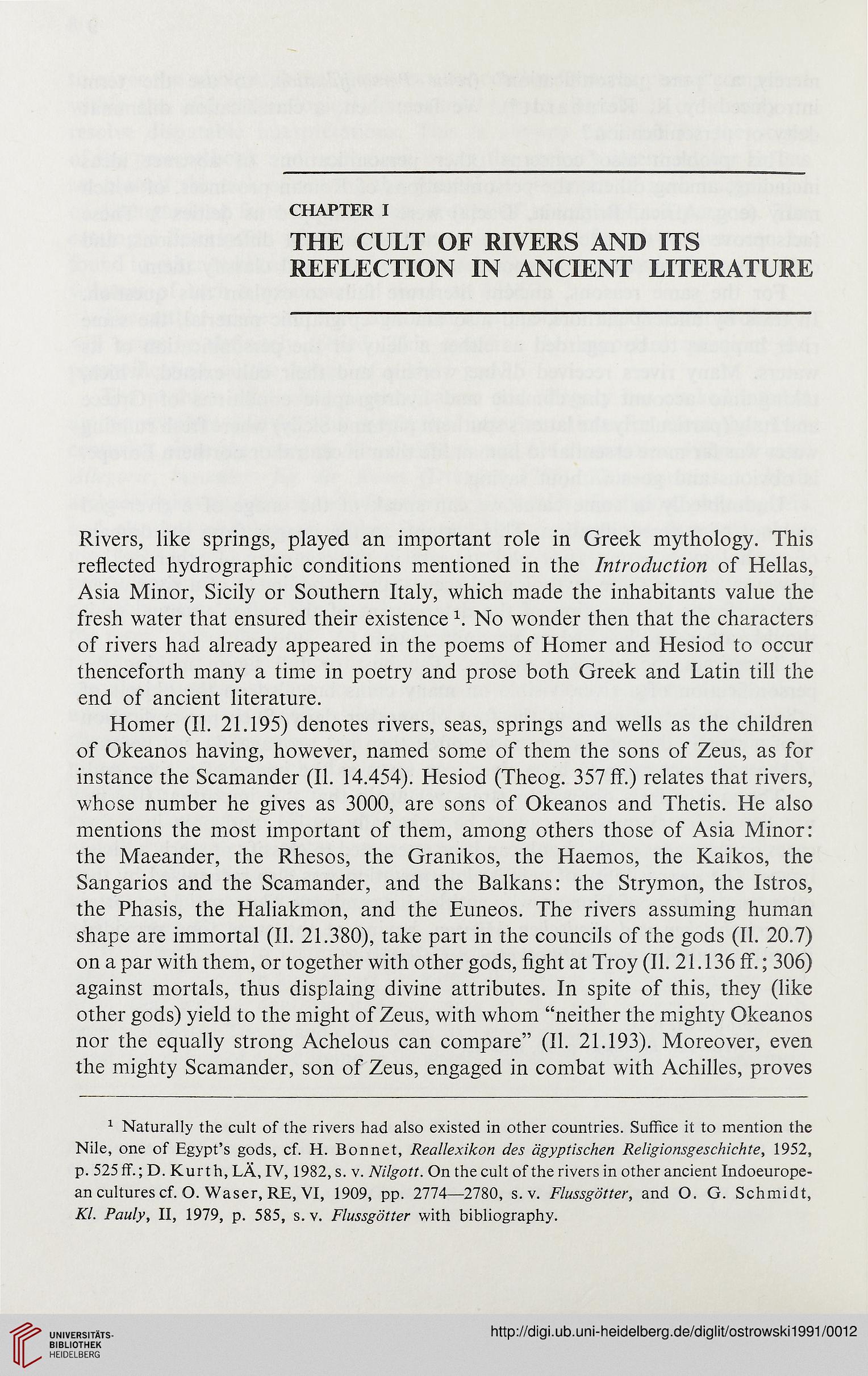CHAPTER I
THE CULT OF RIVERS AND ITS
REFLECTION IN ANCIENT LITERATURE
Rivers, like springs, played an important role in Greek mythology. This
reflected hydrographic conditions mentioned in the Introduction of Hellas,
Asia Minor, Sicily or Southern Italy, which made the inhabitants value the
fresh water that ensured their existence 1. No wonder then that the characters
of rivers had already appeared in the poems of Homer and Hesiod to occur
thenceforth many a time in poetry and prose both Greek and Latin till the
end of ancient literature.
Homer (II. 21.195) denotes rivers, seas, springs and wells as the children
of Okeanos having, however, named some of them the sons of Zeus, as for
instance the Scamander (II. 14.454). Hesiod (Theog. 357 ff.) relates that rivers,
whose number he gives as 3000, are sons of Okeanos and Thetis. He also
mentions the most important of them, among others those of Asia Minor:
the Maeander, the Rhesos, the Granikos, the Haemos, the Kaikos, the
Sangarios and the Scamander, and the Balkans: the Strymon, the Istros,
the Phasis, the Haliakmon, and the Euneos. The rivers assuming human
shape are immortal (II. 21.380), take part in the councils of the gods (II. 20.7)
on a par with them, or together with other gods, fight at Troy (II. 21.136 ff.; 306)
against mortals, thus displaing divine attributes. In spite of this, they (like
other gods) yield to the might of Zeus, with whom “neither the mighty Okeanos
nor the equally strong Achelous can compare” (II. 21.193). Moreover, even
the mighty Scamander, son of Zeus, engaged in combat with Achilles, proves
1 Naturally the cult of the rivers had also existed in other countries. Suffice it to mention the
Nile, one of Egypt’s gods, cf. H. Bonnet, Reallexikon des agyptischen Religionsgeschichte, 1952,
p. 525 ff.; D. Kurth, LA, IV, 1982, s. v. Nilgott. On the cult of the rivers in other ancient Indoeurope-
an cultures cf. O. Waser, RE, VI, 1909, pp. 2774—2780, s. v. Flussgotter, and O. G. Schmidt,
Kl. Pauly, II, 1979, p. 585, s. v. Flussgotter with bibliography.
THE CULT OF RIVERS AND ITS
REFLECTION IN ANCIENT LITERATURE
Rivers, like springs, played an important role in Greek mythology. This
reflected hydrographic conditions mentioned in the Introduction of Hellas,
Asia Minor, Sicily or Southern Italy, which made the inhabitants value the
fresh water that ensured their existence 1. No wonder then that the characters
of rivers had already appeared in the poems of Homer and Hesiod to occur
thenceforth many a time in poetry and prose both Greek and Latin till the
end of ancient literature.
Homer (II. 21.195) denotes rivers, seas, springs and wells as the children
of Okeanos having, however, named some of them the sons of Zeus, as for
instance the Scamander (II. 14.454). Hesiod (Theog. 357 ff.) relates that rivers,
whose number he gives as 3000, are sons of Okeanos and Thetis. He also
mentions the most important of them, among others those of Asia Minor:
the Maeander, the Rhesos, the Granikos, the Haemos, the Kaikos, the
Sangarios and the Scamander, and the Balkans: the Strymon, the Istros,
the Phasis, the Haliakmon, and the Euneos. The rivers assuming human
shape are immortal (II. 21.380), take part in the councils of the gods (II. 20.7)
on a par with them, or together with other gods, fight at Troy (II. 21.136 ff.; 306)
against mortals, thus displaing divine attributes. In spite of this, they (like
other gods) yield to the might of Zeus, with whom “neither the mighty Okeanos
nor the equally strong Achelous can compare” (II. 21.193). Moreover, even
the mighty Scamander, son of Zeus, engaged in combat with Achilles, proves
1 Naturally the cult of the rivers had also existed in other countries. Suffice it to mention the
Nile, one of Egypt’s gods, cf. H. Bonnet, Reallexikon des agyptischen Religionsgeschichte, 1952,
p. 525 ff.; D. Kurth, LA, IV, 1982, s. v. Nilgott. On the cult of the rivers in other ancient Indoeurope-
an cultures cf. O. Waser, RE, VI, 1909, pp. 2774—2780, s. v. Flussgotter, and O. G. Schmidt,
Kl. Pauly, II, 1979, p. 585, s. v. Flussgotter with bibliography.




